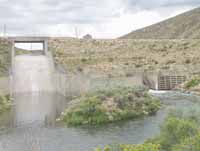| On the surface, the spillway at Scofield Reservoir appears strong and stable. But tests indicate that the slabs and connections in the structure at the dam are weakened to the point that only 25 percent of the stillway’s strength remains. During the next couple of years, the United States Bureau of Reclamation plans to cover the bulk of the costs associated with renovating the structure and rebuilding the gatehouse on the top of the dam. |
Scofield dam was built in the 1940s to provide a stable water supply for agriculture and municipal use in Carbon County.
In the early stages of construction, progress was slow due to a local manpower shortage stemming from World War II. Some of the dam’s construction work was done by Carbon High School students during the summer months.
Scofield dam is still a stable structure, but the spillway is becoming questionable.
The problem was spelled out in a letter from United States Bureau of Reclamation area manager Bruce Barrett to Richard Lee, Carbon Water Conservancy District president.
According to the federal agency, a comprehensive facility review was done at Scofield dam in 2002.
The report from the geologists and engineers who did the review indicated that the static and seismic tests on the dam were acceptable.
However, the results of the facility review showed that the chance for a hydrologic failure had increased considerably compared to past tests conducted on the dam.
Reclamation found “that the hydrologic jacking of the spillway floor slabs during a spilling event could eventually lead to dam failure,” stated Barrett’s letter.
Apparently, the existing floor slabs in the spillway lack modern features designed to prevent that type of occurrence.
The letter pointed out that “reclamation technicians tested the spillway concrete and found that it had virtually no strength” and the “effective thickness of the floor slabs have been reduced by 75 percent.”
With that discovery, the BOR issued a study to identify and implement appropriate remedial actions.
The federal agency’s list included the following items:
•Development of an initial design and engineering cost estimate.
•A value engineering study to ensure that all reasonable alternatives are brought to light and investigated.
•A review board of consultants will be convened and it will review the BOR’s preferred alternative for remedial action.
•The designs and specifications for the project will be developed with input from the consultants, the county water conservancy district, the value engineering study and economic data.
•The consultant board will be reconvened to review the final designs for the renovation.
•When all input is received, U.S. Bureau of Reclamation will make the federal agency’s final revisions to the plans and specifications.
•The a modification report will be prepared and submitted to the U.S. Congress. With congressional approval, work will begin on the spillway rehabilitation project.
Most of the steps will be done this summer and fall, then Congress will get the final report next winter. BOR expects start actual construction work at the dam in summer 2006.
Based on the Reclamation Safety of Dams Act of 1978, Carbon Water Conservancy District will be is responsible for 15 percent of the total cost of the project. The cost will not be known until the review process is completed.
While the federal agency can project costs relatively well, Barrettt’s letter reminded Lee the local water conservancy district is responsible for the actual costs of the project. Therefore, overages or unforeseen problems could affect the total CWCD may have to pay.
“This project is a real good deal for us,” said Leein an interview last week. “This will be the first time the federal government has paid for anything on a rehabilitation like this. Generally, the users have to pay for it.”
Lee has been spending a lot of time visiting and working with BOR officials on the proposed project and has also been able to secure the 15 percent the CWCD will have to pay on a no interest basis.
“When it is all finished we will have a new spillway and a new gatehouse,” he said. “That gate house is so close to the road that runs over the dam that if a person walks out of it without looking they could be run over.”
Another aspect of the project is the fact that the bridge the runs over the spillway is supported by the concrete of the spillway itself. That means a detour will have to be built to get traffic around the area until it can be replaced.
“That bridge is going to be replaced by the Utah Department of Transportation,” said Lee.
In recent years, water in the reservoir has not come close to coming over thr spillway because of the drought. But in a several flood years in the past, the spillway was valuable and the area could return to a wet cycle at any time.
“I guess the best thing about this is that the spillway with be updated with all the modern engineering. That should make the entire structure viable for another 40 to 50 years,” concluded Lee.

